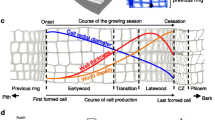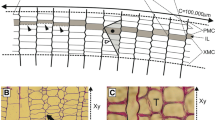Abstract
In trees, new wood develops from a layer of stem cells called the vascular cambium. A subpopulation of cambial cells—the fusiform initials—are elongated and capable of coordinated reorientation in response to internal and external stimuli. Changes in the orientation of fusiform initials in turn leads to changes in the grain pattern of developing wood. This article reviews the phenomenon of cambial orientation, with an emphasis on a recent computer model that takes the plant hormone auxin as the orienting signal. New model results are presented that demonstrate the surprisingly complex grain patterns that can emerge from simple initial conditions, in qualitative agreement with similar patterns found in wood. Lastly, an alternative theory of wood grain pattern that takes mechanical stress as the orienting signal is critically evaluated.









Similar content being viewed by others
References
Aloni R. 2001. Foliar and axial aspects of vascular differentiation: hypotheses and evidence. J Plant Growth Regul 20:22–34
Aloni R, Zimmermann MH. 1983. The control of vessel size and density along the plant axis: a new hypothesis. Differentiation 24:203–208
Andre JP. 2000. Heterogeneous, branched, zigzag and circular vessels: unexpected but frequent forms of tracheary element files: description–localization–formation. In: Savidge RA, Barnett J, Napier R, editors. Cell and Molecular Biology of Wood Formation. Oxford, England, UK: BIOS Scientific Publishers
Bonhoeffer T, Grinvald A. 1991. Iso-orientation domains in cat visual cortex are arranged in pinwheel-like patterns. Nature 353:429–431
Chen C, Mrksich M, Huang S, Whitesides GM, Ingber D. 1997. Geometric control of cell life and death. Science 276:1425–1428
Davies P editor. 2004. Plant Hormones: Biosynthesis, Signal Transduction, Action 3rd edition. Kluwer Academic Publishers, London, England, UK
Davis A-C, Brandenberger R editors. 1994. Formation and Interaction of Topological Defects, Vol 349. New York, USA, Plenum Press
De Gennes PG. 1995. The Physics of Liquid Crystals. Oxford University Press, New York, NY, USA
Eames AJ, MacDaniels LH (1925) An introduction to plant anatomy. McGraw-Hill, New York
Edelstein-Keshet L, Bard Ermentrout G. 1990. Models for contact-mediated pattern formation: cells that form parallel arrays. J Math Biol 29:33–58
Eklund L, Sall H. 2000. The influence of wind on spiral grain formation in conifer trees. Trees 14:324–328
Fayle D, Farrar J. 1965. A note on the polar transport of exogenous auxin in woody root cuttings. Can J Bot 43:1004–1007
Forest L, Padilla F, Martinez S, Demongeot J, San Martin. 2006. Modeling of auxin transport affected by gravity and differential radial growth. J Theor Biol 241:241–251
Galton F. 2005. Finger Prints. Dover Publications, Mineola, New York, USA
Galweiler L, Guan C, Muller A, Wisman E, Mendgen K, et al. 1998. Regulation of polar auxin transport by AtPIN1 in Arabidopsis vascular tissue. Science 282:2226–2230
Goldsmith MHM, Goldsmith TH, Martin MH. 1981. Mathematical analysis of the chemosmotic polar diffusion of auxin through plant tissues. Proc Natl Acad Sci 78:976–980
Gregory FG, Hancock CR. 1955. The rate of transport of natural auxin in woody shoots. Ann Bot 19: 451–465
Gutknecht J, Walter A. 1980. Transport of auxin (indoleacetic acid) through lipid bilayer membranes. J Memb Biol 56:65–72
Harris JM. 1969. On the causes of spiral grain in corewood of radiata pine. N Z J Bot 7:189–213
Harris JM. 1973. Spiral grain and xylem polarity in radiata pine: microscopy of cambial reorientation. N Z J For Sci 3:363–378
Harris JM. 1989. Spiral grain and wave phenomena in wood formation. Springer-Verlag, New York, USA
Hejnowicz Z, Kurczynska E. 1987. Occurrence of circular vessels above axillary buds in stems of woody plants. Acta Soc Bot Pol 56:415–419
Hollis CA, Tepper HB. 1971. Auxin transport within intact dormant and active white ash shoots. Plant Physiol 48:146–149
Iqbal M editor. 1990. The Vascular Cambium. New York, USA: John Wiley & Sons
Johnson CF, Morris DA. 1989. Applicability of the chemiosmotic polar diffusion theory to the transport of indole-3yl-acetic acid in the intact pea. Planta 178:242–248
Kidd W. 1903. The Direction of Hair in Animals and Man. Adam and Charles Black, London, England, UK
Kirschner H, Sachs T, Fahn A. 1971. Secondary xylem reorientation as a special case of vascular tissue differentiation. Isr J Bot 20:184–198
Kozlowski TT, Winget CH. 1963. Patterns of water movement in forest trees. Bot J 124:301–311
Kramer EM. 1999. Observation of topological defects in the xylem of Populus deltoides and implications for the vascular cambium. J Theor Biol 200:223–230
Kramer EM. 2002. A mathematical model of pattern formation in the vascular cambium of trees. J Theor Biol 216:147–158
Kramer EM. 2004. PIN and AUX/LAX proteins: their role in auxin accumulation. Trends Plant Sci 9:578–582
Kramer EM, Borkowski MH. 2004. Wood grain patterns at branch junctions: modeling and implications. Trees 18:493–500
Kramer EM, Groves JV. 2003. Defect coarsening in a biological system: the vascular cambium of cottonwood trees. Phys Rev E 67:041914
Kucken M, Newell A (2005) Fingerprint formation. J Theor Biol 235:71–85
Kurczynska E, Hejnowicz Z. 1991. Differentiation of circular vessels in isolated stem segments of Fraxinus excelsior. Physiologia Plantarum 83: 275–280
Lachaud S. 1989. Participation of auxin and abscisic acid in the regulation of seasonal variations in cambial activity and xylogenesis. Trees 3:125–137
Lachaud S, Bonnemain JL. 1982. Xylogenese chez les dicotyledones arborescentes. III. Transport de l’auxine et activite cambaile dans les jeunes tiges de Hetre. Can J Bot 60: 869–876
Lachaud S, Bonnemain JL. 1984. Seasonal variations in the polar-transport pathways and retention sites of [3H]indole-3-acetic acid in young branches of Fagus sylvatica L. Planta 161:207–215
Larson PR. 1994. The Vascular Cambium. Springer-Verlag, New York, USA
Lee HY, Yahyanejad M, Kardar M. 2003. Symmetry considerations and development of pinwheels in visual maps. Proc Natl Acad Sci USA 100:16036–16040
Lev-Yadun S. 2000. Whirled grain in wood and topological defects. J Theor Biol 205:511–514
Lev-Yadun S, Aloni R. 1990. Vascular differentiation in branch junctions of trees: circular patterns and functional significance. Trees 4:49–54
Lintilhac P, Vesecky T. 1981. Mechanical stress and cell wall orientation in plants. II. The application of controlled directional stress to growing plants; with a discussion on the nature of the wound reaction. Am J Bot 68:1222–1230
Lintilhac P, Vesecky T. 1984. Stress-induced alignment of division plane in plant tissues grown in vitro. Nature 307:363–364
Little CHA. 1981. Effect of cambial dormancy state on the transport of [1-14C]indol-3-ylacetic acid in Abies balsamea shoots. Can J Bot 59:342–348
Mattheck C. 1991. Trees: the Mechanical Design. Springer-Verlag, Berlin, Germany
Mattheck C. 1998. The structural optimization of trees. Naturwissenschaften 85:1–10
Mattheck C, Kubler H. 1995. Wood: the Internal Optimization of Trees. Springer-Verlag, New York, USA
Mitchison GJ. 1980. The dynamics of auxin transport. Proc R Soc Lond B. Biol Sci 209:489–511
Mogilner A, Edelstein-Keshet L. 1995. Selecting a common direction I. How orientational order can arise from simple contact responses between interacting cells. J Math Biol 33:619–660
Neeff F. 1914. Uber Zellumlagerung. Z Bot 6:465–547
Neeff F. 1922. Uber polares Wachstum von Pflanzenzellen. Jahrb] wissenschaft Bot 61:205–283
Nix LE, Wodzicki TJ. 1974. The radial distribution and metabolism of IAA-14C in Pinus echinata stems in relation to wood formation. Can J Bot 52:1349–1355
Novitskaya L 1998. Regeneration of bark and formation of abnormal birch wood. Trees 13:74–79
Odani K 1985. Indole-3-acetic acid transport in pine shoots under the stage of true dormancy. J Jpn For Soc 67:332–334
Pellicane P (1994) Mathematical details of the flow–grain predictor of grain orientation. For Products J 44:51–54
Phillips GE, Bodig J, Goodman JR. 1981. Flow–grain analogy. Wood Sci 14:55–64
Rudinsky JA, Vite JP. 1959. Certain ecological and phylogenetic aspects of the pattern of water conduction in conifers. Forest Sci 5:259–266
Sachs T 1991. Pattern Formation in Plant Tissues. Cambridge University Press, New York, USA
Sachs T. 2000. Integrating cellular and organismic aspects of vascular differentiation. Plant Cell Physiol 41:649–656
Sachs T, Cohen D. 1982. Circular vessels and the control of vascular differentiation in plants. Differentiation 21:22–26
Savidge RA, Barnett J, Napier R editors. 2000. Cell and Molecular Biology of Wood Formation. BIOS Scientific Publishers, Oxford, England, UK
Savidge RA, Farrar J. 1984. Cellular adjustments in the vascular cambium leading to spiral grain formation in conifers. Can J Bot 62:2872–2879
Schrader J, Nilsson P, Herzberg M, Sandberg G, Nilsson J, et al. 2004. A high-resolution transcript profile across the wood-forming meristem of poplar identifies potential regulators of cambial stem cell identity. Plant Cell 16:2278–2292
Schrader K, Baba K, May S, Palme K, Bhalerao R, et al. 2003. Polar auxin transport in the wood-forming tissues of hybrid aspen is under simultaneous control of developmental and environmental signals. Proc Natl Acad Sci USA 100:10096–10101
Schulte P, Brooks J. 2003. Branch junctions and the flow of water through xylem in Douglas fir and Ponderosa pine stems. J Exp Bot 54:1597–1605
Shigo AL. 1985. How tree branches are attached to trunks. Can J Bot 63:1391–1401
Sundberg B, Tuominen H, Little CHA. 1994. Effects of the indole-3-acetic acid (IAA) transport inhibitors N-1-naphthylphthalamic acid and morphactin on endogenous IAA dynamics in relation to compression wood formation in 1-year-old Pinus sylvestris shoots. Plant Physiol 106:469–476
Sundberg B, Uggla C. 1998. Origin and dynamics of indoleacetic acid under polar transport in Pinus sylvestris. Physiol Plant 104:22–29
Sundberg B, Uggla C, Tuominen H. 2000. Cambial growth and auxin gradients. In: Savidge RA, Barnett J, Napier R (eds) Cell & Molecular Biology of Wood Formation. BIOS Scientific Publishers, Oxford, England, UK, pp 169–188
Sutton A, Sutton M. 1981. Le Monde des Arbres. Paris, France, Larousse
Swarup R, Kramer EM, Perry P, Knox K, Leyser O, et al. 2005. Root gravitropism requires lateral rooot cap and epidermal cells for transport and response to a mobile auxin signal. Nat Cell Biol 7:1057–1065
Tuominen H, Peuch L, Fink S, Sundberg B. 1997. A radial concentration gradient of indole-3-acetic acid is related to secondary xylem development in Populus. Plant Physiol 115:577–585
Uggla C, Mellerowicz E, Sundberg B. 1998. Indole-3-acetic acid controls cambial growth in Scots pine by positional signaling. Plant Physiol 117:113–121
Uggla C, Moritz T, Sandberg G, Sundberg B (1996) Auxin as a positional signal in pattern formation in plants. Proc Natl Acad Sci USA 93:9282–9286
Vieten A, Vanneste S, Wisniewska J, Benkova E, Benjamins R, et al. 2005. Functional redundancy of PIN proteins is accompanied by auxin-dependent cross regulation of PIN expression. Development 132:4521–4531
Wentworth CK. 1931. Twist in the grain of coniferous trees. Science 73:192
Wilcox DA. 2000. Basic Fluid Mechanics. La Canada, CA, USA, DCW Industries
Wloch W. 1976. Cell events in the cambium, connected with the formation and existence of a whirled cell arrangement. Acta Soc Bot Pol 45:313–326
Wunderlich RC, Heerema NA. 1975. Hair crown patterns of human newborns: studies on parietal hair whorl locations and their direction. Clin Pediatr 14:1045–1049
Zagorska-Marek B, Little CHA. 1986. Control of fusiform initial orientation in the vascular cambium of Abies balsamea stems by indole-3-ylacetic acid. Can J Bot 64:1120–1128
Zamski E, Wareing PF. 1974. Vertical and radial movement of auxin in young sycamore plants. New Phytol 73:61–69
Zimmermann MH, Brown C (1971) Trees: structure and function., Springer-Verlag, New York, USA
Acknowledgments
We thank Tobias Baskin, Mike Bergman, and Jennifer Normanly for helpful conversations, and Henrik Jonsson for a critical reading of the mansucript. Research assistants Mike Borkowski and Joe Groves made valuable contributions to the development of the model. This work was supported in part by Simon’s Rock College, and by the National Research Initiative of the U.S. Department of Agriculture Cooperative State Research, Education and Extension Service, grant number 2003-35103-13793.
Author information
Authors and Affiliations
Corresponding author
Rights and permissions
About this article
Cite this article
Kramer, E.M. Wood Grain Pattern Formation: A Brief Review. J Plant Growth Regul 25, 290–301 (2006). https://doi.org/10.1007/s00344-006-0065-y
Received:
Accepted:
Published:
Issue Date:
DOI: https://doi.org/10.1007/s00344-006-0065-y




